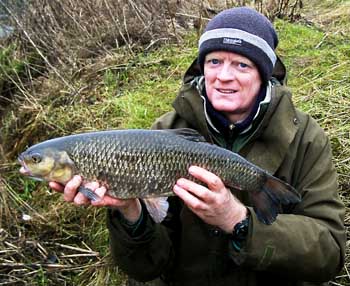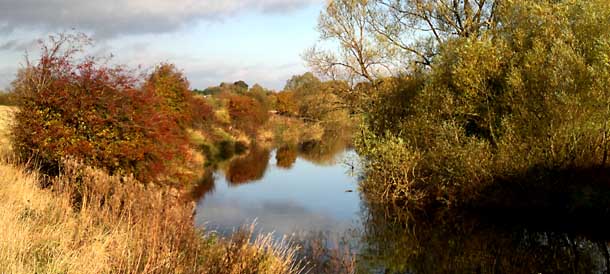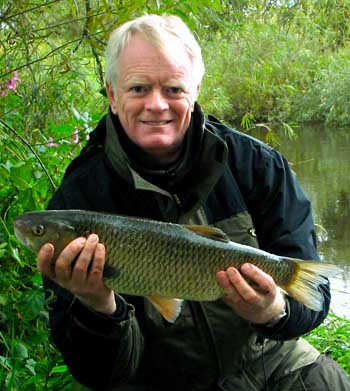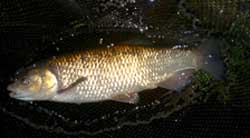Westlin Winds
“Now westlin winds and slaughtering guns
Bring Autumn’s pleasant weather.”
Not the most obvious way to start a love poem, but hey, who am I to criticise Rabbie Burns! The words of the poem popped into my mind as I walked across the fields towards the river Swale on a beautiful Autumn day.

“The sky is blue, the fields in view all fading green and yellow” and the distant scarp of the North York moors glows gold in the warm sunshine. From somewhere in the distance came the bark of a 12 bore as a farmer thinned out the local rabbit population.
Today I should have been bagging on Clattercote, but low water levels had scuppered that so it was time to start my Winter chub campaign. As always, the aim is a Yorkshire six, but whilst a few five pounders are a realistic target a six is a tall order from the Yorkshire rivers. Still, I’ve come close on a few occasions so I live in hope!
 |
| A big 5 from the Swale |
There were no cars in the car park when I arrived so I know I’ll have the stretch to myself and as I prefer a roving approach this will suit me down to the ground. Before I left home I checked the EA web site and it showed the Swale still carrying a few inches of water from the rain earlier in the week. Because of this I’ve left the bread at home and I’ll be using maggots on this session with pellets as a backup bait. As I climb the stile into the top field I pause to admire the Swale in all its Autumn glory. The river looks in superb condition, but I know from experience that it will be carrying a heavy tannin stain from the vast peat moors in the upper reaches. Whilst this won’t make the fishing easy it will allow me to fish relatively light tackle as there’s little chance of a nuisance barbel.

It’s a long walk to the top of the length and I’m sweating as I finally arrive and work my way carefully down the steep bank. The river has the colour of strong black tea and is pushing through with some purpose. I pause for a while to consider my options. I’ve brought two quiver tip rods with me: one is a Fox Avon Duo with a 2oz quiver tip and the other is a Fox Barbel Special which has a 3oz quiver tip.
If the flow is too strong for a quiver tip, or if I decide that float fishing is the best option, I’ve got a lovely cane Sabrina tucked away in my holdall, but I suspect that the lissom nymph will remain hidden until called on to liberate a lady later in the year. I decide that the lighter tip should just cope with the flow so I set up the Avon Duo. My main line is 8lb Okuma Sensitech with a hook length of 6lb Preston Grand Match fluoro and a size 14 Drennan feeder hook is at the business end. I attach a 50g black Cap feeder and I’m ready to go.
Before my first cast I catapult a few halibut pellets across to the far side where there is some good tree cover. I then add a good handful of pellet based method mix to my maggots. The particles of method mix come out of the feeder as it sinks forming a cloud of attractive particles which drift down stream, hopefully drawing chub up into my swim.
For the first half hour I cast regularly to get some bait into the swim and as I’m not catching I then ease off so I don’t over feed. After an hour without a fish I take a break and wander off downstream to find my next swim. I feed a handful of pellets and a few handfuls of maggots and return to my first swim for another hour. There’s no sign of a fish so I gather my gear together and move down to my second swim. Before I fish this swim I locate a third swim and feed some pellets and maggots before returning to my second swim.
I repeat this process twice more, giving each swim an hour before moving. It’s now mid afternoon and I decide to fish my fourth swim into dark. This swim allows me to fish two rods so I set up my second rod with a banded 8mm carp pellet and soaked pellets in the feeder. I fish my maggot feeder at the top of the swim and the pellet rod about 20 yards downstream.
I now change my tactics slightly on the maggot rod and keep a steady trickle of loose feed going in and restricting my casting to once every 15 minutes. I’m also using a lighter feeder (the smallest Black Cap) which just holds in the slower flow in this swim.
 |
| This chub weighed 4lbs 15½ oz |
After an hour I get a slight indication on the maggot rod, then 5 minutes later the tip pulls round slightly and holds. I strike and feel the satisfyingly solid resistance of a good chub. I love the way chub fight. There are none of the showy pyrotechnics of the barbel, but instead an honest, stubborn struggle during which you’re on tenterhooks in case the fish finds sanctuary in some unseen snag. This chub does manage to find the remains of a weed bed, but I manage to extricate it and slip the net under a fine fish of just under 5lbs.
I take the risk of returning this fish, but I get my carp sack ready in case I catch more fish. Returning chub to a swim can be the kiss of death and I find that they are fine for a few hours in the confines of the sack. Half an hour later I get another of the gentle indications which I think is so typical of confident chub. The tip moves less than an inch, yet the fish is hooked well inside the mouth. These bites rarely develop into good pull-rounds as the fish invariably seems to be able to eject the hook without pricking itself. This fish is slightly smaller, but still over four pounds. Just after I return it the tip of my pellet rod slams round as an over confident chub of about three pounds realises the error of its ways.
 As the light fades I land another four pounder and then lose a good fish from a hook pull. The fish are obviously getting wary and I’m now getting the quick pulls and taps that are typical of nervous chub. Just as I’m about to pack up I get screaming take on the pellet rod which turns out to be a chub of about 4 ½ lbs.
As the light fades I land another four pounder and then lose a good fish from a hook pull. The fish are obviously getting wary and I’m now getting the quick pulls and taps that are typical of nervous chub. Just as I’m about to pack up I get screaming take on the pellet rod which turns out to be a chub of about 4 ½ lbs.
As I walk back to the car I reflect on the day. The fishing certainly hasn’t been easy and the chub have had to be searched out. The tannin probably hasn’t helped their appetites either which possibly why they rapidly became cautious. Still, I’ve had a decent start to my chub fishing and whilst the two biggest fish haven’t been massive they’ve got the length to make five pounders later in the season.
Some Thoughts:-
Conditions
The heavy tannin stain caused by run-off from peat moors is peculiar to the spate rivers of Northern England (Southern rivers that suffer from this are largely game rivers). When the rivers are in this state coarse fish are reluctant to move far from where they are lying up. They must be searched out and care should be taken not to overfeed.
Tackle
Most of my chub fishing is done using a quiver tip rod coupled with a feeder. The Fox Avon Duo that I started with today is an ideal general chub rod with a test Curve of about 1lb and interchangeable quiver tips. Days like today have convinced me that when rod tip ledgering you just won’t see many indications that would result in a hooked fish if you were using a quiver tip. Confident chub often give very small indications which I suspect are due to them taking the bait back to their pharyngeal teeth without moving far and then ejecting the bait if they feel the hook.
The only time I don’t use a feeder is when I’m getting indications I can’t hit or when I want to keep feed to a minimum. I’m happy to float fish, but conditions today were just not right in my experience. The float is best suited to clear or slightly coloured rivers.
Rigs
I tend to use a fairly long hook length when chub fishing and will generally start at around 30 inches, adjusting the length as needed through the session. If there’s little chance of a barbel then I’ll usually use a low diameter hook length with a breaking strain of 6lb, dropping to 4lb if conditions demand it. If barbel are likely then I’ll always use braid, effectively fishing with light barbel gear. I’m not a fan of big baits and so my hooks are generally on the small side with a 16 or 14 for maggot fishing, a 14 for pellet and a 12 or 10 for bread.
There has been debate in the forums on bolt rigs and their place in chub fishing. Bolt rigs were developed for fishing still waters for a fish that will generally move after taking the bait and so they consist of a short hook length and a heavy weight with the aim of pricking the fish and causing it to run. The problem is that rigs behave differently in rivers.
For example there is little advantage in using a short hook length unless the fish rises in the water or moves upstream after taking the bait. If it moves downstream then the length of the hook length is largely irrelevant as the fish will feel the weight immediately irrespective of the length.
The other key item in a bolt rig is the heavy weight. The problem with using a heavy weight is that chub often don’t move (much) after taking a bait (this is why chub bites are often just gentle pulls and twitches). When using a heavy weight the movement of the fish is not enough to move the weight so you don’t see any indication and because there is little or no tension in the hook length the fish can often still eject the bait and hook without the hook point finding a hold.
In my opinion using a weight heavier than is needed to hold bottom when chub fishing is a last resort to be used only when fishing for spooky fish that give unhittable bites.
Bait
Chub love pellets and boilies. The problem is that they seem to be able to deal with hard baits much more easily than they can soft baits. Because of this I almost invariably use maggots or bread for my chub fishing. This season, though I’m experimenting with ground pellets mixed in with my maggots so that when used in a feeder I get a cloud of particles washing downstream.
Location
In this session I fished classic chub swims close to features where I thought chub might be holed up. In better conditions chub shoals will roam over the whole of the river so it’s always worth fishing apparently featureless lengths of water. You’ll be surprised at how often “cyanide straight” produces a really good fish.










